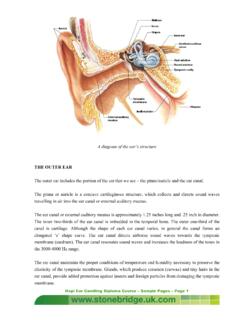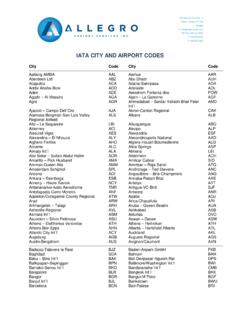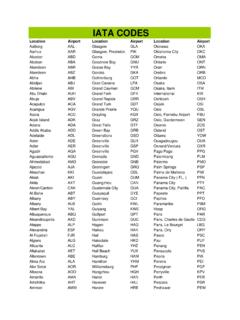Transcription of Air Fares & Ticketing 2 (IATA Level 1)
1 1 Level 2 - TelesalesAir Fares & Ticketing 2 (IATA Level 1)Approved by and leading to the city & Guilds Qualification at Level 2 CONTENTSJ argon Buster 5 Outcome 1:Describe iata Codes 13 Outcome 2: iata Terms & Fares 45 Outcome 3 Select the most appropriate fare for a given itinerary 93 Outcome 4 Constructing Basic Fares using the Mileage System 173 Outcome 5 Identify baggage allowances, taxes, fees and charges 243 Outcome 6 Interpret Ticketing entries and associated document entries 259 Mock Papers 287 Aims & OutcomesThe aim of this unit is to enable learners to construct a range of Fares for given are nine outcomes to this unit. The candidate will be able to: Describe iata codes Define iata areas Explain iata terms and definitions Identify fare types Select the most appropriate fare for a given itinerary/journey Construct basic Fares using the mileage system Interpret Ticketing entries and associated document entries Identify baggage allowances, taxes, fees and charges Identify payments Exercise What 1.
2 Ryan Air a. A schedule airline b. A charter airline c. A low-cost carrier 2. Easyjet a. A schedule airline b. A charter airline c. A low-cost carrier 3. Qantas a. A schedule airline b. A charter airline c. A low-cost carrier 4. Aer Lingus a. A schedule airline b. A charter airline c. A low-cost carrier 5. Thomson Fly a. A schedule airline b. A charter airline c. A low-cost carrier 6. Qantas a. A schedule airline b. A charter airline c. A low-cost carrier 4 Learn TravelInternational Air Transport Association ( iata ) iata The Air Transport Industry s link with governments and the public, as well as being the airlines representative in international organisations The main aim of iata is to promote safe, regular and economical air transport worldwide for the benefit of everyone. Most of the world s major scheduled airlines (over 200) in some 120 countries are members of this association.
3 In addition, there are many scheduled airlines, which, although not members of iata , still adopt the same standards and procedures as the iata provides the machinery for member airlines to collaborate and co-operate on all aspects of air transportation (technical, legal, financial etc.) despite the differences in languages, currencies, laws and the public, one result of this airline co-operation is that an individual passenger can arrange to travel through many countries using the services of several air carriers with payment for the complete journey in a single ensure quick and efficient communication, especially for reservations purposes, there are agreed procedures and codes that you will is the first item on the agenda, as you will be using iata codes and procedures throughout this Area DefinitionsA sound knowledge of geography is an essential requirement in the industry, especially the ability to find countries and cities quickly on a map.
4 In addition, you will find that many rules and regulations apply to specified geographical areas. All these areas are clearly defined by at the map opposite, you will see that iata divides the world into 3 areas known as Traffic Conference (TC) areas. This means that when a meeting is called in one of the areas, only those airlines that operate from or within that particular area need & airport CodesEach city with an airport has a 3-letter iata code that is used in reservation mes-sages, Fares and Ticketing . Often, the first three letters of the city name are used, is ATHENSSIN is SINGAPOREDEN is DENVERSome codes are instantly recognisable, even when the first three letters are not used. is NAIROBIHKG is HONG KONGSome codes are difficult to remember, in particular the Canadian city codes. (All Canadian city codes start with a Y)YMQ is MONTREALYEA is EDMONTONTake care, there are some traps.
5 Never guess - if you are not sure about the code for a city always check. is LAGOS, not LOS ANGELESMAR is MARACAIBO not MARSEILLEFare Basis CodesCodes are comprised of a number of codes include at least one letter. This is known as the Prime code and indicates the class of travel the passenger has booked. The codes to be entered give information such as:Type of fare Category of passenger Class entitlement Minimum and maximum stay validity Reservations entitlement Seasonality Days of travel Exercise Decode the following fare basis codes: 1. LHWAP3M: 2. LXSX1M: 3. SBB: 4. LZZ: 5. Y/CH25: 6. YEE3M/IN90: 7. YKSX2M. 8. YHPX6M. 9. VWSS. 10. HHXSS2M. 8 Learn TravelGlobal Indicators (GIs)For certain destinations it is possible for passengers to travel by alternative routes. From the UK to New Zealand, for example, they may either travel in an Easterly direction, perhaps stopping at points in Asia and Australia; alternatively there is a service which crosses the Atlantic, stopping at a point in the USA, and then across the Pacific to the destination.
6 In these situations the Fares tables give Global Indicators (GI).There are a number of Global Indicators:Eastern Hemisphere EHFar East FETrans Siberian TSAtlantic Pacific APAtlantic ATPacific PANorth Pacific NPRussian Route RUThese routes are explained in more detail on the next two pages. Exercise Refer to the Rules reproduced in the Appendix to answer the following questions. 1. What is the Minimum Stay requirement for a ticket issued for a PEX fare Japan to Kenya, subject to Rule Y021? 2. What is the Minimum Stay requirement for a ticket issued for a PEX fare Germany to Hong Kong subject to Rule Y148? 3. What length of break of journey is defined as a STOPOVER for flights Malaysia to UK subject to Rule E073? 4. What would be the PENALTY if a passenger cancelled a flight, subject to Rule Y135, from London to Bangkok, BEFORE scheduled departure?
7 5. What percentage of the adult fare is payable by a CHILD travelling London to Nairobi with a ticket subject to Rule Y055? 6. How many STOPOVERS are permitted on a flight Stockholm to Tel Aviv subject to Rule E100? 7. What percentage of the adult fare is payable by a CHILD travelling London to Cape Town with a ticket subject to Rule Y064? 10 Learn TravelOpen JawAn open jaw When you travel to one city and return from another The Fares we have constructed so far have all been for continuous travel. The passenger travelled by air between each point in the itinerary. Not all journeys are like this though. A holiday-maker might fly from London to Paris, spend some time touring in France, and return directly to London from Nice. They fly into one city in the country, but depart from another. Their travel between the two points is by means other than air.
8 This is an Open Jaw travelling at Normal Fares this would be abbreviated as NOJ, if the fare is a Special fare the abbreviation would be OJ. Open Jaw journeys within Europe are generally only allowed using a domestic surface break. In the case above the open sector is at the turnaround. If the journey is with Normal Fares it may also be referred to as a Turnaround Normal Fare Open Jaw (TNOJ).The open sector can also be in the country of origin. A client might be in Glasgow, fly from there to Toronto, and return directly from Toronto to London. This is still an Open Jaw, but may also be called an Origin Open Jaw (OOJ) or Origin Normal Open Jaw (ONOJ).Journeys can also have open sectors at both the origin, and the turnaround. A journey outward Manchester to New York, returning Miami to London, would be a Double Open Jaw (DOJ).Extra Mileage SurchargeAll the previous examples had itineraries with the total TPM within the MPM.
9 An itinerary is permitted to exceed MPM, by no more than 25%, providing that the fare is increased. These mileage surcharges apply in stages: For a mileage increase of: the fare is increased by:Not more than 5%: 5%More than 5%; but not more than 10%: 10%More than 10%; but not more than 15%: 15%More than 15%; but not more than 20%: 20%More than 20%; but not more than 25%: 25%You cannot have a mileage percentage increase higher than 25%. This would require a completely different calculation that is covered in a different calculate the percentage by which a TPM exceeds the MPM DIVIDE the TPM by the MPMIf the result is:Between and - increase the fare by 5%.Between and - increase the fare by 10%.Between and - increase the fare by 15%.Between and - increase the fare by 20%.
10 Between and - increase the fare by 25%.Linear Fare Calculation EntriesLinear format is the fare calculation on : LON LO elements in this quite simple construction are:First Entry: LON - the city three letter code of the starting point of the itinerary. Note that the city code is used; airport codes ( LHR) are NEVER used in fare Entry: LO - the carrier operating the first Entry: The first destination flown to from LON, in this case WAW Fourth Entry : In this case, the next part of the entry is comprised of a number of elements that are printed without any spacing between the fare, in NUC, for that fare component . the total fare, in NUC for the entire itinerary. END to indicate that the fare construction is finished. Where a fare construction element ending with a digit is followed by one starting with a letter (or vice versa), no space appears between them.





